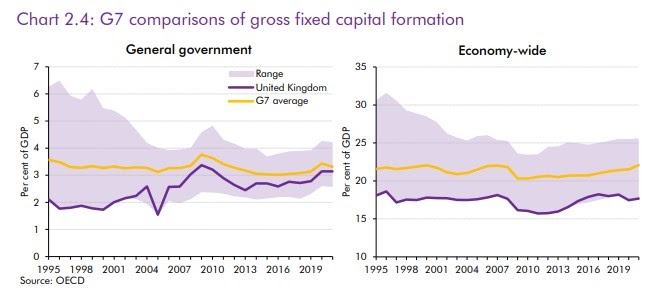On 30th October
Rachel Reeves will be setting out her first budget, rather than
responding to someone else’s decisions. She will be leading the
public discussion, not following the narrative set by another. That
will be obvious in terms of tax, because she will be raising taxes
rather than pretending to permanently cut them. But it should also be
true for the fiscal rules that she commits the government to follow.
In his first budget
of 1997, Gordon Brown set out his own fiscal rules. They were very
different from anything followed by his predecessor, and they were
innovative at the time. They lasted for ten years, derailed only by a
global crisis and the worst recession since WWII. The forthcoming
October budget is also a chance for Rachel Reeves to establish her
own fiscal rules that are better and last much longer than those of
her predecessors. [1]
Last week’s
discussion of why we have fiscal rules gives us three basic
properties that good fiscal rules should have:
-
They should
discourage politicians from using deficit finance (paying for higher
spending or lower taxes by borrowing or creating reserves (money))
simply to avoid the unpopularity of raising taxes or cutting
spending, rather than for any good economic reason. -
Conversely
they should not prevent deficit finance when this makes sense in
economic terms. For example there are good reasons why fluctuations
in public investment should be financed by borrowing, and
overwhelming reasons why a deficit financed fiscal stimulus should
be used when an economy is at risk from, in, or recovering from a
recession. -
Fiscal rules
should focus on underlying trends, rather than short or medium term
fluctuations in spending (wars, pandemics, greening the economy)
that have no strong implications for sustainability.
Fiscal rules that do
not have these properties are bad rules, and it
is better to have no fiscal rules than bad fiscal
rules.
One of the fiscal
rules that Reeves says she will follow largely has these properties,
and one clearly does not. The rule that does is sometimes called the
golden rule, and it states that in the medium term day to day public
spending (all spending except investment) should be equal to total
taxes. Specifically this involves a rolling five year ahead target
for the current budget deficit (public spending excluding public
investment minus taxes) of zero. However, as governments since
Cameron/Osborne have acknowledged, and as first proposed in Portes
and Wren-Lewis, this target has to be conditional on
the economy not being close to, in or recovering from a recession.
[2]
The conditional
golden rule achieves property (1). It achieves (2) because it doesn’t
apply during a recession, and the current balance excludes public
investment. A rolling five year ahead target helps achieve (3),
because forecasts five years ahead almost always involve the economy
being on its medium term path. It is often suggested that having a
rolling target rather than a target for a fixed date is bad because
it ‘lets politicians off the hook’. This is false, particularly
if forecasts are done by an independent body like the OBR. In
contrast having a target for a fixed date fails property (3). As we
move closer to that date fiscal policy will be responding to short
term shocks, which makes
for bad policy.
Although a
conditional medium term golden rule goes a long way to satisfying
property (3), it fails to take account of spending that is medium but
not long term. The clearest example of that today is spending that
helps the transition to green energy. For this reason, if I were
Chancellor I would task the OBR with calculating how much of the
current deficit is due to policy aimed at encouraging this green
transition, and adjust the target to exclude this spending. Any
government that lets a fiscal rule delay the green transition has got
its priorities criminally wrong.
I have seen it
recently argued that the last year of the last government showed that
deficit based fiscal rules failed, because it didn’t prevent that
government from making incredible assumptions about future spending
so it could cut taxes. That is a misunderstanding. What the fiscal
rules did, combined with an independent OBR forecast, was force the
last government to make assumptions that amounted to further
austerity in order to make tax cuts. That these plans amounted to
further austerity was widely commented on by experts in the
independent media. Without a fiscal rule and the OBR to monitor
compliance, I’m sure the last government would have claimed that it
would cut taxes and increase public spending! [3]
The other fiscal
rule that Reeves appears to have adopted, which does come from her
predecessor, is for a falling debt to GDP ratio five years ahead.
This, when you already have the golden rule, is a terrible fiscal
rule. I have not come across a single serious economist who defends
it, and plenty of eminent economists who understand the damage it is
doing (e.g FT
here, or ungated
here). The rest of this post is about all the reasons
why this rule is not fit for any purpose except keeping economic
growth down.
The first point to
make is that, if the medium term conditional golden rule is in place,
there is no need for an additional rule to achieve property (1). The
golden rule does that just fine. In that sense the falling debt to
GDP rule is completely superfluous [4]. Unfortunately that rule fails
properties (2) and (3), because it discourages much needed
investment. This is the reason I sometimes call it the suppressing
public investment rule.
Suppressing public
investment is exactly what the previous government was doing for
fourteen years, and the terrible state of our public sector is partly
a result of that. This was perhaps why that government was so
attached to this rule. In contrast, Reeves has spoken many times
about the need for additional public investment, so it makes no
economic sense for her to adopt a rule designed to suppress that
investment.
We currently need a
surge in public investment to catch up all the ground we have lost.
But the case for much higher public investment is even stronger than
that, as recent
research from the OBR clearly shows. Their paper first
shows how public and private investment are really low in the UK
compared to other G7 countries.
Public investment
began rising towards the G7 average in the first decade of this
century, but austerity cuts set that back. Private investment is no
better, but that is partly because public and private investment are
often complements.
The OBR, using very
reasonable assumptions, calculates that if public investment was
increased by 1% of GDP permanently, potential output would be 0.4%
higher after 5 years. The impact on potential output goes on rising
steadily, to reach 2.4% after 50 years. The paper also looks at what
these assumptions imply for average rates of return and benefit to
cost ratios. Of course the whole point of a good investment strategy
is to choose individual projects that have a high return, and make
sure these projects are not thwarted by some archaic fiscal rule.
What the OBR’s analysis shows clearly is that increasing public
investment is an excellent way to help improve the UK’s recently
dire growth performance.
The falling debt to
GDP rule is classic mediamacro. It comes from the idea that
government debt is a ‘bad thing’ by making false and selective
comparisons to household debt, that current levels are ‘obviously’
too high, and so debt needs to be brought down. It’s a rule that
economists advise against but political advisers say is essential to
maintain ‘political credibility’, which is code for what
non-economists in the media think should happen. Everyone from
political journalists to the great and the good like to opine about
fiscal rules while having little knowledge. It is they, not
economists, the markets or even
GOD, that think maintaining such a bad fiscal rule is essential
for credibility, and they are wrong about this just as they were
wrong about 2010 austerity.
Reeves should take
the opportunity of her first budget to consign this rule to the
dustbin. The new OBR analysis of public investment provides the
perfect excuse to do so, if she needed an excuse. [5] A comment from the National Institute argues that the OBR’s analysis may underestimate the impact of public investment on economic growth.
What should take its
place as Reeves’ second fiscal rule? Nothing. You don’t need a
second fiscal rule. It serves no purpose, beyond the bad one of
suppressing useful public investment. As
I argued here, replacing it with a target for falling
net public sector worth to GDP is just double counting. It makes
sense to look at public sector net worth when looking at
sustainability over the longer term (beyond five years), but having
it as part of a fiscal rule is not sensible.
Yes, the
Conservative opposition will claim that abandoning the falling debt
to GDP rule allows the Chancellor to have slightly higher spending
(about half a percentage point of GDP, according to the last OBR
forecast) and higher public investment. Most voters will be happy
about that. No one in the bond market will be worried – why should
they be, when the OBR calculates that public investment almost pays
for itself in generating higher taxes. [6] Much more importantly,
abandoning this rule will allow the Chancellor to expand public
investment to boost economic growth and green the economy. Getting
rid of the falling debt to GDP rule is really a no-brainer for any
Chancellor whose main concern is the health of the economy rather
than the media commentariat might say.
[1] Part of the
cynicism surrounding fiscal rules is a consequence of the last
government, which changed fiscal rules even more frequently than the
Prime Minister. Sometimes this wasn’t because the rules they
replaced would have been broken, but just as a political ploy to
wrongfoot the opposition. Essentially the last government used the
misconceived media credibility they got from austerity to devalue the
concept of a fiscal rule.
[2] Formally, the
lower bound for nominal interest rates makes it essential that we
have fiscal stimulus to prevent, moderate or recover from a
recession. The exact form this conditionality takes is a second
order, though important, problem.
[3] There is an
issue about the OBR being forced to make forecast assumptions it
strongly suspects are false, which I
discussed here. This is an issue about the OBR’s mandate, not about fiscal rules.
[4] In fact the
falling debt to GDP rule has nothing to do with the basic principle
of ensuring debt sustainability. Instead it is based on the
presumption that the current debt to GDP ratio is too high, and as I
discussed in my previous post there is no evidence for this.
[5] If Reeves is
planning to keep this silly rule, and has already adjusted her plans
so that the rule is met, it is not too late. She could be politically
clever and announce both the end of this rule, but also that her
fiscal plans would have met the rule anyway, showing that the rule is
being ditched on good economic grounds rather than so she can spend
more or tax less.
[6] That doesn’t mean that long term interest rates will not rise. They may if additional public investment adds to already strong aggregate demand (in the face of weak aggregate supply), and markets anticipate that this will put upward pressure on interest rates. The obvious way to avoid that is to increase taxes.




